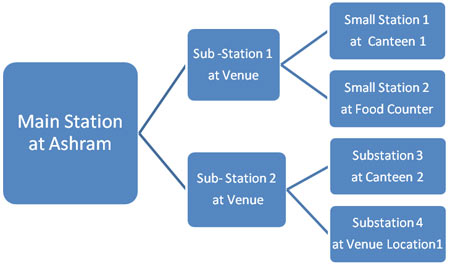Cleaning is also a celebration
To keep India Clean and Green, Amma said in her Birthday Message that the MAM is ready to construct public toilets in schools and public places if state governments, school management committees and local people collaborate. This project will be initiated in Kerala. Thereafter, it will be implemented gradually in other states of India. {read}
Amma always leads by example. The best possible example of ‘Cleaning Management’ was exhibited during Amma’s 57th Birthday Celebrations at Amritapuri. The ashram was visited by lakhs of people during 26th and 27th of September. Any congregation of such size always leaves behind unimaginable quantities of waste in the form of papers, food, plastic bottles etc.
What surprised me more was not the number of people, not the scale of arrangement, but the management after the completion of the event. By 28th evening, the entire venue was brought back to a state as it was before the event started. This was an amazing scene to see no waste in any form across the venue. “The main reason for such a feat is Amma’s teachings and principles” said Brahmachari Gurudas who was the heading the cleaning team.
The entire cleaning process was executed in a meticulously planned manner. For Amma’s 57th Birthday, the devotees from abroad, requested Amma to give them a chance to serve Amma by being a part of the Cleaning Management Operation. The team consisted of Amma’s devotees from India and abroad, students of various educational institutes of Amrita University and ashram inmates. The pictorial representation below gives an overview of the methodology employed for the cleaning operations

Fig 1. A pictorial representation of the cleaning operations during Ammas 57th Birthday
There were more than 300 people participating in this operation. There were more than 100 small stations located at various locations across the venue. Each of these small stations had a specially made waste bin divided into 4 sections – one section for hard plastic like toothbrush, broken mugs etc; second section for recyclable waste like mineral water bottles; third section for food waste and the fourth section for paper, cardboard etc. Each of these small stations was manned by 2 to 3 volunteers who guided the people in disposing the waste in the respective sections. The waste from these small stations was sent to sub stations.
There were two Sub –Stations located beside the entrance of the engineering college. All the waste that was collected from each of the small stations was collected here. The movement of waste from the small stations to the sub stations was done using hand carts. The sub stations had 2 trucks always available to carry the collected and segregated waste from these sub stations to the Main Station in the Ashram.
The Main Station was located in the Ashram, wherein all these waste from the sub stations was collected and sent to various treatment plants depending on the nature of the waste. For example, all the recyclable waste was sent to the recycling unit in the Ashram. This unit uses the state of the art technology for recycling the products. The food products are sent to the compost unit, where they are converted to organic manure.
In this manner unimaginable quantities of so called ‘waste’ is collected and converted into forms that are used in various areas. The concept of ‘waste’ doesn’t exist here. There is nothing that cannot be reused.
No other public event of this scale can achieve this feat in just 24 hours. All the volunteers’ partipating in this entire process were seen smiling and enjoying what they did. That is the inspiration of the power of LOVE.
-Avinash Shivdas
